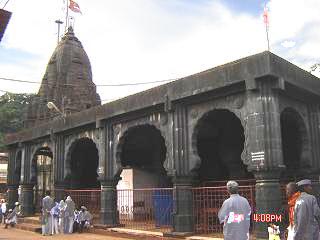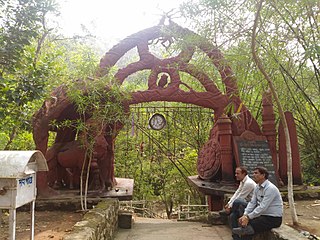
Trimbakeshwar Shiva Temple is an ancient Hindu temple in the town of Trimbak, in the Trimbakeshwar tehsil in the Nashik District of Maharashtra, India, 28 km from the city of Nashik and 40 km from Nashik road. It is dedicated to the god Shiva and is one of the twelve Jyotirlingas, where the Hindu genealogy registers at Trimbakeshwar, Maharashtra are kept. The origin of the sacred Godavari river is near Trimbak.

Bhimashankar Temple is a Jyotirlinga shrine located 50 km Khed taluka, near Pune, in Maharashtra, India. It is located 127 km from Shivajinagar in the Ghat region of the Sahyadri Mountains. Bhīmāshankar is also the source of the river Bhima, which flows southeast and merges with the Krishna river near Raichur. The other Jyotirlinga shrines in Maharashtra are Trimbakeshwar near Nashik and Grishneshwar.

The Bhima River is a major river in Western India and South India. It flows southeast for 861 kilometres (535 mi) through Maharashtra, Karnataka, and Telangana states, before entering the Krishna River. After the first sixty-five kilometers in a narrow valley through rugged terrain, the banks open up and form a fertile agricultural area which is densely populated.

Omkareshwar is a Hindu temple dedicated to God Shiva. It is one of the 12 revered Jyotirlinga shrines of Shiva. It is on an island called Mandhata or Shivapuri in the Narmada river at Khandwa District in Madhya Pradesh, India; the shape of the island is said to be like the Devanagari ॐ symbol.

Mahakaleshwar Jyotirlinga is a Hindu temple dedicated to Lord Shiva and is one of the twelve Jyotirlingams, shrines which are said to be the most sacred abodes of Lord Shiva. It is located in the ancient city of Ujjain in the state of Madhya Pradesh, India. The temple is situated on the side of the holy river KShipra. The presiding deity, Lord Shiva in the lingam form is believed to be Swayambhu, deriving currents of power (Shakti) from within itself as against the other images and lingams that are ritually established and invested with mantra-shakti.
Kanse is a village located in Ambegaon tehsil in Pune district, Maharashtra state in India.

Bhimashankar Wildlife Sanctuary was created in the Ambegaon and Khed talukas of Pune District, in the Western Indian state of Maharashtra in order mainly to protect the habitat of the Indian Giant Squirrel.

Hemadpanti Sculpture is an architectural style, named after its founder, the prime minister Hemadpant from the court of Seuna Yadavas of Devagiri.

Maharashtra is the third largest state of India. It has a long history of Marathi saints of Varakari religious movement, such as Dnyaneshwar, Namdev, Chokhamela, Eknath and Tukaram which forms the one of bases of the culture of Maharashtra or Marathi culture. Maharashtra had huge influence over India under the 17th-century king Shivaji of the Maratha Empire and his concept of Hindavi Swarajya which translates to self-rule of people.

Nageshvara is one of the temples mentioned in the Shiva Purana and is one of the twelve Jyotirlingas.

Shree Moteshwar Mahadev, also known as Shree Bheem Shankar Mahadev, is an abode of Lord Shiva in Kashipur of Uttarakhand state,India. This place was known as the Dakini State in ancient days.

Ambegaon taluka is a taluka in Shirur subdivision of Pune district of state of Maharashtra in India. One of the twelve most revered Shiva temples or Jyotirlinga, the Bhimashankar Temple is in this taluka.

Khed or Rajgurunagar is a taluka in the Khed subdivision of Pune district of the state of Maharashtra in India. Khed is the headquarter of the taluka. The taluka is known for being the birthplace of Santaji Jagnade.The name of city is rajgurunagar on the name of Shaheed Shivram Hari Rajguru.

A Jyotirlinga or Jyotirlingam, is a devotional representation of the Supreme God Shiva. Jyoti means 'radiance' and lingam the 'Image or Sign' of Shiva; Jyotir Lingam thus means the Radiant Sign of The Almighty Shiva. There are twelve traditional Jyotirlinga shrines in India.

Bhimashankar Jyotirlinga (Dakinyam), Bhimpur, is a Hindu temple situated in the western part of the holy Mahendragiri mountains on the Mahendratanaya river in the Indian state of Odisha. It is debated to be the Dakini area and the Jyotirlingam found there is believed to be one among the 12 Jyotirlingams.

The Bhimeswar Dwadas Jyotirlinga Dham, one of the Jyotirlingas, is located at Dakini hill near Pamohi in Guwahati. It is situated at the hill just besides the Deepor Beel. It is believed that Lord Shiva had incarnated here to destroy a demon called Bhimasura and protect his devotees.

The Laxmi Narsimha Temple is a Hindu temple dedicated to Lord Narasimha, an Avatar of Vishnu, located in western India, in Pune district of the state of Maharashtra. The temple is located at the confluence of Bhima river and Nira river, at the south eastern tip of Pune district, in Indapur taluka. Shri Narsimha of Nira Narsingpur is the family deity of many people from Maharashtra the prominent ones being the families of the previous Chief Minister of Maharashtra, Shri Devendra Fadnavis and the Vinchurkar family.

The Chaskaman Dam is one of the important dams of Maharashtra and is built on the Bhima River at Rajgurunagar in Pune district. It is located across river Bhima in Krishna basin near Village Bibi in Khed taluka. The main purpose of this dam was to improve irrigation and supply of electricity to the nearby villages. It is the second Hydel Greenfield power project in the country that is capable of captive power as well. The power will be utilized through the state power board. The project is completed during 2008-09.

The city of Pune and the surrounding district have been at the centre of the history of Maharashtra for more than eight hundred years, and a number of places revered by Marathi Hindu people are located in the district. These revered places include five of the eight Ashtavinayak Ganesh temples. The Samadhi or the resting places of the two most revered Marathi Bhakti saints, namely Dnyaneshwar and Tukaram are located at Alandi and Dehu respectively. The main temple of Khandoba, the family deity for most Marathi Hindus, is also located in the district at Jejuri. The oldest temple in the city is the Pataleshwar rock-cut temple complex which was built during the 8th century.

Bhorgiri Fort is a fort in Pune district near to Bhimashankar in the Indian state of Maharashtra.



















